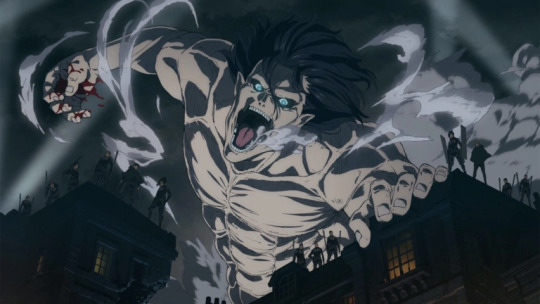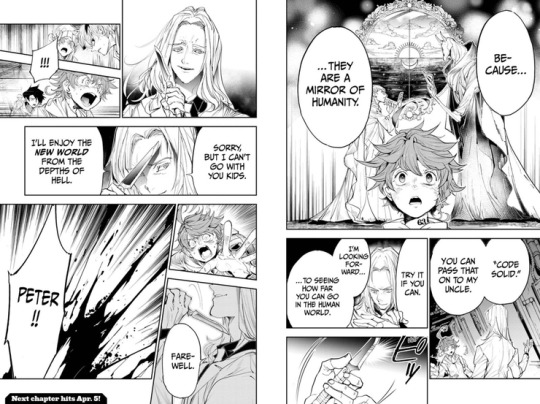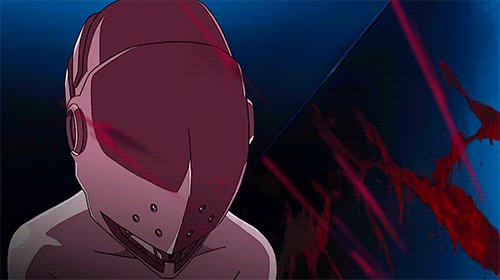Text
The Commodification and Consumption of Violence and how it Alters our Views on Fictional Violence

trigger warning: death, blood, gore, suicide, violence
The presentation of violence in the media has a definitive influence on the opinions that we formulate concerning characters, of which they are either victims or perpetrators, and how people perceive the overall story. The violence displayed is often left to the viewer to interpret and to compartmentalize their emotions in regards to the scene. Furthermore, it is left in the hands of the viewer to discern their reactions based on the actions portrayed.
Framing the Situation
Media frames violence within certain contexts in the narrative and characterization of a story and that provides fans with an avenue to condemn or justify the actions. As well, violence can be produced and have its interpretations be dependent on external factors created by the humans.
For example, the framing of this scene:

Within the context of the story, the violence depicted in this manner is both horrific and terrifying to the reader, especially as the reader grapples with the scenes prior being just as blunt and brutal in its depiction. However, the ways in which people are made to interpret this scene within the story set the tone for the way in which they react towards the violence against the aggressor and against the persecuted.
While the violence is horrifying, the ways in which it is packaged within the story, and thereby made consumable, alters the judgement of readers. It makes them sympathize with those who escaped the violence, but feel that the persecutor was deserving of his “punishment”, despite its horrific means.
Compared to these panels:

The framing of the violence is presented in a way that the viewer no longer feels vengeful or that the aggressor was deserving of his judgement.
This scene is framed in a way that the viewer feels pity and to some extent understanding towards the antagonist. The means of presenting this scene are done so in a way that the reader can understand and relate to the nihilistic view of the character, thereby creating a mode of justification for his legacy, actions, and ultimately the death he receives.
The contrast in depictions of violence within both scenes creates two alternative framings of violence which can redirect the audiences feelings towards the violence being perpetuated.
Our empathy is only extended as far as to one party, which relays that the ways in which violence is portrayed affects the means by which fans react to it when it occurs against certain characters under specific circumstances. In spite of the violence committed by each of the characters, the structure of the story allowed for readers to regard both violent deaths in different views.
The Biased Eye
The formation of a bias within the media creates a barrier and acts as a preventative measure through which criticisms are unreached and the acts of a character are either understandable or reprehensible.
In the clips of the character, the viewer is made to understand that the acts that the character has committed are vile, and that she may even be viewed as evil. However, by creating a character with an aesthetic and “cute” appeal to her, it creates a deterrent for people to properly judge her actions. If anything, it serves as a muddler on people’s moral compass. The aesthetic of the character in contrast to her actions is difficult to take in because she does not fit into the stereotype of an “ugly” and “wretched” looking villain, thereby clouding people’s perception of the character in tune with her acts.

Another form of bias towards the character is visible in this scene. While the viewer understands that the girl has committed murder and that she has hurt the people around her, the way she is depicted as being hurt and thrown out by her "father-figure" create pockets of sympathy and understanding which can eventually evolve into justification. As well, the background of this character makes her almost relatable enough that people can even see themselves within her and relate to the pain that she experiences. With an understanding of the character, their actions thus also become understandable and therefore lead people to legitimize their actions.
The biases that people create around characters despite their violent actions creates a moral ambiguity within the viewer. Therefore, they are able to skew the scene to fit a narrative they have constructed around the violence that takes place.
Primitive Curiosity
Another pushing factor in the formation of opinions on violence against fictional characters is the primal curiosity that inhabits a portion of people’s minds. While people are civilized beyond acting out on primal urges, nonetheless, there is still a part of the mind that finds curiosity within the brutal and grotesque.

In this anime, gore plays a central element to the story that is being depicted. The brutalities of the deaths shown are sickening and remind the viewers that the character causing the destruction is not human. While viewers are naturally unnerved by the violence depicted, there is still a small part of them that is intrigued or even entertained by the violence. People may automatically react with disgust towards the violence enacted, but they may also feel curious enough to dismiss the actions of the character in order to continue viewing the ravaging that is being committed.
youtube
The scene depicted in this anime is vicious and bloodthirsty. The theme of war and its fatalities are graphically depicted as viewers consume scenes with ferocious violence and bloodshed. The initial reaction to the scene depicted is one of shock and horror that evolves into inklings of excitement. As the initial shock of the scene dissolves, the viewer then becomes involved with the extreme nature of the scene and begins to view it with pleasure or amusement. While the acts of war are inadmissible, people may become caught up in the viciousness in the battle that it becomes about the adrenaline of the scene rather than the ruthlessness of violence.
Human morality pushes primal curiosity into furthest recesses of the mind, however that does not permanently banish it from existence. People may find relief from this curiosity through the violent nature of the media. The excitement that this media arouses in people thus clouds their judgement and ability to appropriately address the violence being portrayed. Primal curiosity acts as a buffer to the judgement of violence depicted on screen.
Conclusion
There are many factors that push or pull people from acceptance or denial of violence that is depicted on screen. People consume media at high rates and thereby formulate opinions based on a vapid viewing of the media they watched. There are many reasons that people may agree or disagree with the acts of violence depicted, and the primary influences are the ways in which violence is packaged and consumed. How people view media and how it is presented to them thereby frames the narrative they construct around the violence they consume. Violence becoming an easily accessible commodity has constructed a warped and distorted perspective that allows for the acts of violence perpetrated in fiction to be debated and examined as deserved, justified, and understandable or as unforgivable, menacing, and atrocious. The state in which violence is viewed and interpreted creates amongst people a means to decide how they view the violence portrayed and how they wish to address it.
0 notes
Text
**DRAFT** The Commodification and Consumption of Violence and how it Alters our Views on Fictional Violence

tw: death, blood, gore, suicide, violence
The presentation of violence in the media has a definitive influence on the opinions that we formulate surrounding the characters affected and the ways in which we feel about the story and episode. When we witness violence either directed towards or by a character it is left up to the viewer to decide and interpret their actions. Furthermore, it is left in the hands of the viewer to decide their reactions and base their judgement of the actions portrayed.
Media will often frame violence within certain contexts that regard such acts within the state of the story and the nature of characterization as a means that provides fans with the opportunity to understand the framing of the violence and thereby create an avenue for people to condemn or justify the acts. As well, violence can be produced and have its interpretations be dependent on external factors created by human forces.
Framing the Situation
For example, the framing of this scene:

Within the context of the story, the violence depicted in this manner is both horrific and terrifying to the reader, especially as they reader grapples with the scenes prior being just as blunt and brutal in its depiction. However, the ways in which people are made to interpret this scene within the story set the space for the way in which they react towards the violence against the aggressor and that which was against the persecuted.
While the violence is horrifying, the ways in which it is packaged within the story, and thereby made consumable, alters the judgement of readers. It makes them sympathize with those who escaped the violence, but feel that the persecutor was deserving of his "punishment", despite its violent means.
Compared to these panels:

The framing of the violence is presented in a way that the viewer no longer feels vengeful or that the aggressor was deserving of his judgement.
This scene is framed in a way that the viewer feels pity and to some extent understanding towards the antagonist. The means of presenting this scene are done so in a way that the reader can understand and relate to the nihilistic view of the character creating a mode of justification for his legacy, actions, and ultimately the death he receives.
The contrast in depictions of violence within both scenes creates two alternative framings of violence which can redirect the audiences feelings towards the violence being perpetuated.
Our empathy is only extended as far as to one party, which shows that the ways in which violence is portrayed affects the means by which we react to it when it occurs towards certain characters under specific circumstances.
The Biased Eye
The formation of a bias within the media creates a barrier and acts as a preventative measure through which criticisms are unreached and the acts of a character are either understandable or reprehensible.
In the clips that we see of the character the viewer is made to understand that the acts that the character has committed are vile, and that she may even be viewed as evil. However, by creating a character with an aesthetic and “cute” appeal to her, it creates a deterrent for people to serve onto her the proper judgement based on her actions. If anything, it serves as a muddler on people’s moral compass. The aesthetic of the character in contrast to her actions is difficult to take in because she does not fit into the stereotype of an “ugly” and “wretched” looking villain, thereby clouding people’s perception of the character in tune with her acts.

Another form of bias towards the character is visible in this scene. While the viewer understands that the girl has committed murder and that she has irreprehensibly hurt the people around her, the way in which she is depicted as being hurt by her “father-figure” and thrown out provides slivers of sympathy and understanding towards this character that can eventually grow beyond slivers to evolve into justification. As well, the storytelling of this character makes her almost relatable enough that people can even see themselves within her and the pain that she experiences.
The biases that people create around characters despite their violent actions creates a moral ambiguity within the viewer. Therefore, they are able to skew the scene to fit a narrative they have constructed around the violence that takes place.
Primitive Curiosity
Another pushing factor in the formation of opinions on violence against fictional characters is the primal curiosity that inhabits a portion of people’s minds. While people are civilized beyond acting out in primal urges, nonetheless, there is still a part of the mind that finds curiosity within the brutal and grotesque.

In this anime, gore plays a central element to the story that is being depicted. The brutalities of the deaths shown are sickening and remind the viewers that the character causing the destruction is not human. While viewers are naturally unnerved by the violence depicted, there is still a small part of them that is intrigued or even entertained by the violence. People may automatically react with disgust towards the violence enacted, but they may also feel curious enough to dismiss the actions of the character.
There are many factors that pull or push people from the violence that is depicted on screen through a 2-D frame of lens. People consume media at high rates and formulate opinions at a top velocity. There are many reasons that people may favor or disagree with the acts of violence depicted, and the primary influences are the ways in which these violences are packaged and sold to be consumed. How people view media and how it is presented to them thereby frames the narrative that they construct around the violence they consume and how they are able to interpret it. Violence becoming an easily accessible commodity has constructed a warped and distorted perspective that allows for the acts of violence perpetrated in fiction to be debated and examined as deserved, justified, and understandable or as unforgivable, menacing, and atrocious. The state in which violence is viewed and interpreted creates amongst people a means to decide how they view the violence portrayed and how they wish to address it.

0 notes